The Relationship Between Tectono-Magmatism and Gold (Polymetallic) Deposits in the Northeastern Hunan Province, Jiangnan Orogen: Insight from Three-Dimensional Electrical Structures
Abstract
1. Introduction
2. Geological Setting
2.1. Tectonic Outline
2.2. Mineral Deposits
3. Regional Geophysical Setting
4. Data and Method
4.1. Data Acquisition and Processing
4.2. Dimensionality Analysis
4.3. Three-Dimensional Inversion
4.4. Resistivity Model
4.5. Sensitivity Tests
5. Discussion
5.1. Crustal Electrical Structure and Geophysical Interpretation
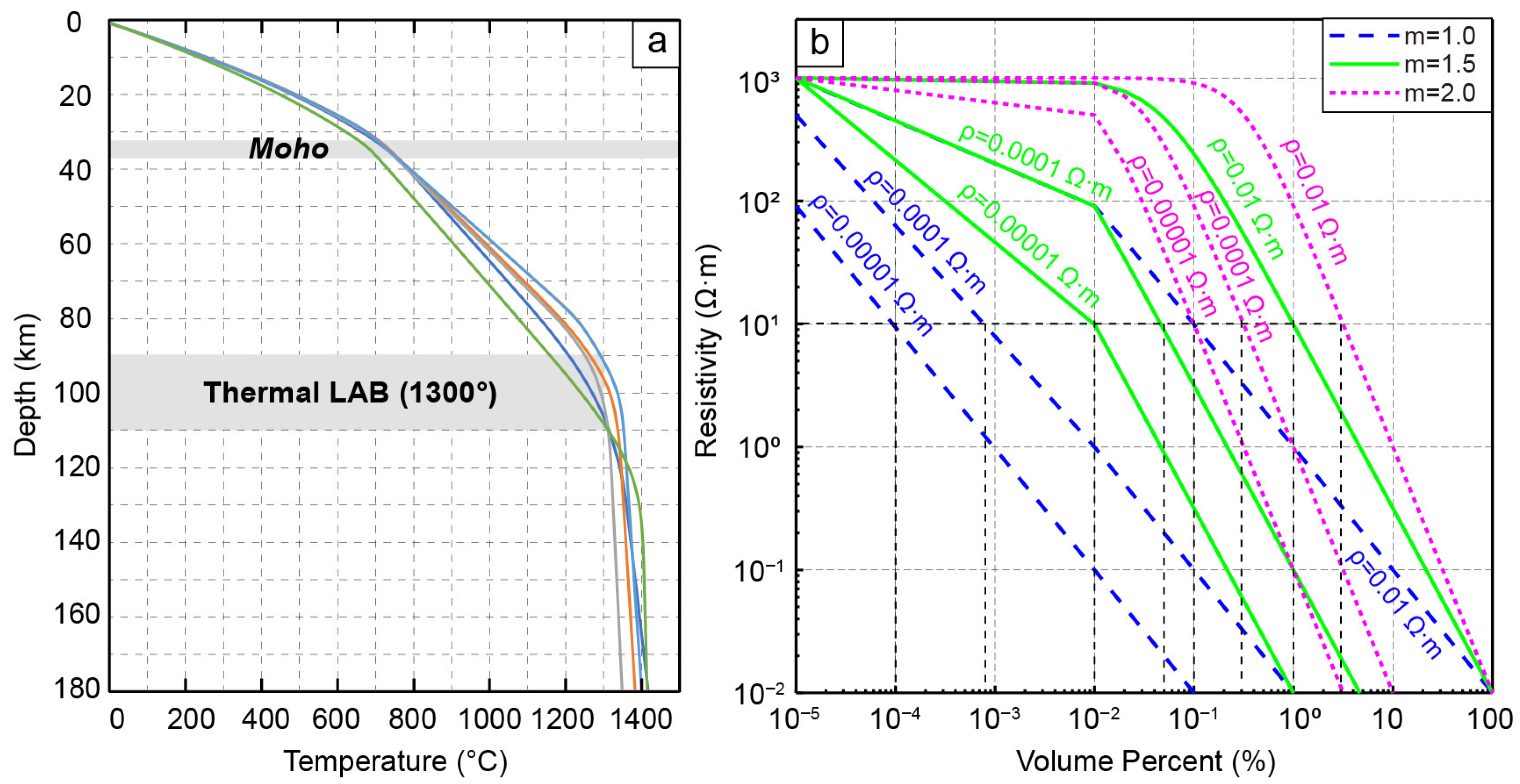
5.2. Upper Mantle Electrical Structure
5.3. Lower Crustal Rheology and Metallogenic Control Framework
5.4. Structural Evolution and Metallogenic Dynamics
6. Conclusions
Supplementary Materials
Author Contributions
Funding
Data Availability Statement
Acknowledgments
Conflicts of Interest
References
- Shu, L.; Yao, J.; Wang, B.; Faure, M.; Charvet, J.; Chen, Y. Neoproterozoic plate tectonic process and Phanerozoic geodynamic evolution of the South China Block. Earth-Sci. Rev. 2021, 216, 103596. [Google Scholar] [CrossRef]
- Li, J.; Dong, S.; Zhao, G.; Zhang, Y.; Xin, Y.; Wang, J.; Lu, Y. Late Mesozoic continental deformation, deep processes, and geodynamic evolution of South China. Acta Geol. Sin. 2024, 98, 829–861. [Google Scholar] [CrossRef]
- Wang, Y.; Fan, W.; Zhang, G.; Zhang, Y. Phanerozoic tectonics of the South China Block: Key observations and controversies. Gondwana Res. 2013, 23, 1273–1305. [Google Scholar] [CrossRef]
- Chen, X.; Xiong, J.; Sun, H.; Huang, C. Analysis on tungsten ore-control factors and the prospecting significance to Fuquanshan area in northeast Jiangxi province. Contrib. Geol. Miner. Resour. Res. 2024, 39, 192–199. [Google Scholar]
- He, Y.; Huang, Z.; Huang, S.; Lü, Y.; Xu, H.; Jiang, B. Prospecting Prediction Based on Integrated Information of Geophysics and Geochemistry in Yajiangqiao Uranium area, east Hunan. Contrib. Geol. Miner. Resour. Res. 2024, 39, 249–255. [Google Scholar]
- Zhang, Z.; Hou, Z.; Lü, Q.; Zhang, X.; Pan, X.; Fan, X.; Zhang, Y.; Wang, C.; Lü, Y. Crustal architectural controls on critical metal ore systems in South China based on Hf isotopic mapping. Geology 2023, 51, 738–742. [Google Scholar] [CrossRef]
- Zeng, Y.; Wang, Q.; Groves, D.I.; Santosh, M.; Wang, Y.; Wang, T.; Yang, L.; Chen, W.; Deng, J. Prolonged Mesozoic intracontinental gold mineralization in the South China Block controlled by lithosphere architecture and evolving Paleo-Pacific Plate subduction. Earth-Sci. Rev. 2023, 240, 104387. [Google Scholar] [CrossRef]
- Xu, D.; Deng, T.; Chi, G.; Wang, Z.; Zou, F.; Zhang, J.; Zou, S. Gold mineralization in the Jiangnan Orogenic Belt of South China: Geological, geochemical and geochronological characteristics, ore deposit-type and geodynamic setting. Ore Geol. Rev. 2017, 88, 565–618. [Google Scholar] [CrossRef]
- Groves, D.I.; Santosh, M.; Zhang, L. A scale-integrated exploration model for orogenic gold deposits based on a mineral system approach. Geosci. Front. 2020, 11, 719–738. [Google Scholar] [CrossRef]
- Magee, C.; Stevenson, C.T.E.; Ebmeier, S.K.; Keir, D.; Hammond, J.O.S.; Gottsmann, J.H.; Whaler, K.A.; Schofield, N.; Jackson, C.A.L.; Petronis, M.S.; et al. Magma plumbing systems: A geophysical perspective. J. Petrol. 2018, 59, 1217–1251. [Google Scholar] [CrossRef]
- Xu, D.; Deng, T.; Dong, G.; Ning, J.; Wang, Z.; Zhang, J.; Zou, F.; Zhou, Y.; Chen, G.; Yu, D.; et al. Zircon U-Pb geochronological and geochemical characteristics of the Lianyunshan two-mica monzogranites in northeastern Hunan Province: Implications for petrogenesis and tectonic setting associated with polymetallic mineralization. Earth Sci. Front. 2017, 24, 104–122. [Google Scholar] [CrossRef]
- Xu, D.; Yu, D.; Wang, Z.; Li, B.; Chi, G.; Zhou, Y.; Zou, S.; Deng, T.; Zhang, S.; Wang, X. Zircon U-Pb and muscovite 40Ar/39Ar dating of Pb-Zn-(Cu) polymetallic deposits in northeastern Hunan Province, Jiangnan Orogen: Evidence for large-scale mineralization in South China at ca. 150–120 Ma. Ore Geol. Rev. 2022, 150, 105200. [Google Scholar] [CrossRef]
- Wang, C.; Shao, Y.-J.; Goldfarb, R.; Tan, S.-M.; Sun, J.; Zhou, C.; Zheng, H.; Liu, Q.-Q.; Xiong, Y.-Q. Superimposed gold mineralization events in the Tuanshanbei orogenic gold deposit, Central Jiangnan Orogen, South China. Econ. Geol. 2024, 119, 113–137. [Google Scholar] [CrossRef]
- Mao, J.; Kerrich, R.; Li, H.; Li, Y. High 3He/4He ratios in the Wangu gold deposit, Hunan province, China: Implications for mantle fluids along the Tanlu deep fault zone. Geochem. J. 2002, 36, 197–208. [Google Scholar] [CrossRef]
- Wang, C.; Shao, Y.-J.; Chen, X.; Xiong, Y.-Q.; Tan, S.-M.; Liu, Q.-Q. Ore-fluid source of multiphase gold mineralization at Tuanshanbei in the central Jiangnan Orogen (NE Hunan, South China): Insight from geology, quartz H-O and monazite in-situ Nd isotope compositions. Ore Geol. Rev. 2023, 157, 105420. [Google Scholar] [CrossRef]
- Xu, D.; Dong, G.; Wang, Z.; Ning, J. Geochemical tracing of ore deposits. In Metallogenic System and Deep-Seated Resource Prospecting for Intracontinental Gold (Polymetallic) Deposits in Northeastern Hunan Province; Xu, D., Dong, G., Wang, Z., Ning, J., Eds.; Science Press: Beijing, China, 2023; pp. 174–338. [Google Scholar]
- Yu, D.; Xu, D.; Wang, Z.; Xu, K.; Huang, Q.; Zou, S.; Zhao, Z.; Deng, T. Trace element geochemistry and O-S-Pb-He-Ar isotopic systematics of the Lishan Pb-Zn-Cu hydrothermal deposit, NE Hunan, South China. Ore Geol. Rev. 2021, 133, 104091. [Google Scholar] [CrossRef]
- Zhang, H.; Lü, Q.; Wang, X.; Han, S.; Liu, L.; Gao, L.; Wang, R.; Hou, Z. Seismically imaged lithospheric delamination and its controls on the Mesozoic Magmatic Province in South China. Nat. Commun. 2023, 14, 2718. [Google Scholar] [CrossRef]
- Yan, J.; Lü, Q.; Zhang, Y.; Liu, W.; Wang, X.; Chen, C.; Xu, Y.; Liu, J. The deep boundaries of Jiangnan orogenic belt and its constraints on metallogenic: From the understanding of integrated geophysics. Acta Petrol. Sin. 2022, 38, 544–558. [Google Scholar] [CrossRef]
- Xu, Y.; Lü, Q.; Zhao, D.; Yan, J.; Shi, D.; Zhang, Y.; Ruan, S.; Xu, Z.; Chen, C.; Zhang, W.; et al. Upper mantle shear velocity structure of the Cathaysia Block and surrounding areas: New insight into deep geodynamics. Tectonophysics 2024, 892, 230542. [Google Scholar] [CrossRef]
- Wang, S.; Zhou, T.; Fan, Y.; Yuan, F.; Zhang, D.; Wang, F.; Chang, Y. Linking deep processes and spatio-temporal evolution of the Yanshanian metallogenic systems in the middle-lower Yangtze River and Qin-Hang metallogenic belts. Sci. China Earth Sci. 2025, 68, 1742–1766. [Google Scholar] [CrossRef]
- Lü, Q.; Dong, S.; Tang, J.; Shi, D.; Chang, Y.; Group, S.C. Multi-scale and integrated geophysical data revealing mineral systems and exploring for mineral deposits at depth: A synthesis from SinoProbe-03. Chin. J. Geophys. 2015, 58, 4319–4343. [Google Scholar] [CrossRef]
- Müller, D.; Groves, D.I.; Santosh, M.; Yang, C. Critical metals: Their mineral systems and exploration. Geosyst. Geoenviron. 2025, 4, 100323. [Google Scholar] [CrossRef]
- Chave, A.D.; Jones, A.G. The Magnetotelluric Method: Theory and Practice; Cambridge University Press: New York, NY, USA, 2012; pp. 1–584. [Google Scholar]
- Heinson, G.; Duan, J.; Kirkby, A.; Robertson, K.; Thiel, S.; Aivazpourporgou, S.; Soyer, W. Lower crustal resistivity signature of an orogenic gold system. Sci. Rep. 2021, 11, 15807. [Google Scholar] [CrossRef] [PubMed]
- Kirkby, A.; Czarnota, K.; Huston, D.L.; Champion, D.C.; Doublier, M.P.; Bedrosian, P.A.; Duan, J.; Heinson, G. Lithospheric conductors reveal source regions of convergent margin mineral systems. Sci. Rep. 2022, 12, 8190. [Google Scholar] [CrossRef]
- Murphy, B.S.; Huizenga, J.M.; Bedrosian, P.A. Graphite as an electrically conductive indicator of ancient crustal-scale fluid flow within mineral systems. Earth Planet. Sci. Lett. 2022, 594, 117700. [Google Scholar] [CrossRef]
- Jin, S.; Sheng, Y.; Liu, C.; Wei, W.; Ye, G.; Jing, J.; Zhang, L.; Dong, H.; Yin, Y.; Xie, C. A review of relationship between the metallogenic system of metallic mineral deposits and lithospheric electrical structure: Insight from magnetotelluric imaging. Minerals 2024, 14, 541. [Google Scholar] [CrossRef]
- Yin, Y.; Jin, S.; Wei, W.; Lü, Q.; Ye, G.; Jing, J.e.; Zhang, L.; Dong, H.; Xie, C. Lithosphere structure and its implications for the metallogenesis of the Nanling Range, South China: Constraints from 3-D magnetotelluric imaging. Ore Geol. Rev. 2021, 131, 104064. [Google Scholar] [CrossRef]
- Jia, D.; Hu, R.; Lu, Y.; Xie, G.; Qiu, X. Characteristics of the mantle source region of sodium lamprophyres and petrogenetic tectonic setting in northeastern Hunan, China. Sci. China Ser. D Earth Sci. 2004, 47, 559–569. [Google Scholar] [CrossRef]
- Sun, S.; Yang, L.; Zhang, L.; Olin, P.; Gao, X.; Li, R.; Wang, J.; Li, Z.; Zhang, F.; Wen, T. In-situ trace elements on pyrite and arsenopyrite of the Zhengchong gold deposit, Jiangnan Orogen: Insights for the mineralization mechanism. Ore Geol. Rev. 2020, 122, 103486. [Google Scholar] [CrossRef]
- Madayipu, N.; Li, H.; Elatikpo, S.M.; Ghaderi, M.; Heritier, R.s.N.n.; Hu, X.-J.; Zheng, H.; Wu, Q.-H. Tracing fluid exsolution and hydrothermal alteration signature of the Mufushan Nb–Ta–(Li–Be–Cs) deposit, South China: An apatite perspective. J. Geol. Soc. 2024, 181, jgs2023-087. [Google Scholar] [CrossRef]
- Deng, T.; Xu, D.; Chi, G.; Wang, Z.; Chen, G.; Zhou, Y.; Li, Z.; Ye, T.; Yu, D. Caledonian (Early Paleozoic) veins overprinted by Yanshanian (Late Mesozoic) gold mineralization in the Jiangnan Orogen: A case study on gold deposits in northeastern Hunan, South China. Ore Geol. Rev. 2020, 124, 103586. [Google Scholar] [CrossRef]
- Zhang, Y.; Shao, Y.; Liu, Q.; Huang, K.; Zhang, X.; Chen, J.; Chen, Z. Constraints on the genesis of the Wangjiawan gold deposit, northeast Hunan district, Jiangnan Orogen: Evidence from fluid inclusions and H-O-S-Pb isotopes. Ore Geol. Rev. 2024, 167, 106018. [Google Scholar] [CrossRef]
- Wang, Z.; Zhang, X.; Liu, Q.; Shao, Y.; Wu, S.; Pan, Z.; Chen, M.; Zhang, Y.; Wu, H. Genesis of the Lishupo gold deposit in the Jiangnan Orogen, NE Hunan (South China): Biotite Ar-Ar, zircon U-Pb ages and H-O-S-Pb isotopic constraints. Ore Geol. Rev. 2022, 145, 104890. [Google Scholar] [CrossRef]
- Madayipu, N.; Li, H.; Ghaderi, M.; Soh Tamehe, L.; Zhou, H.-X.; Wu, Q.-H.; Zheng, H.; Chen, Y.-L.; Kang, F. Contrasting Nb-Ta mineralization between the Mufushan and Lianyunshan granites, South China: Evidence from whole-rock and zircon geochemistry and geochronology. Ore Geol. Rev. 2023, 158, 105487. [Google Scholar] [CrossRef]
- Madayipu, N.; Li, H.; Muhammad Elatikpo, S.; Förster, M.W.; Zhou, H.-X.; Zheng, H.; Wu, Q.-H. Magmatic-hydrothermal evolution of long-lived Nb-Ta-(Sn) mineralization in Lianyunshan, NE Hunan, South China. GSA Bull. 2023, 135, 2691–2709. [Google Scholar] [CrossRef]
- Madayipu, N.; Li, H.; Algeo, T.J.; Elatikpo, S.M.; Zheng, H.; Wu, Q.-H.; Chen, Y.-L.; Sun, W.-B. Chemical and boron isotopic compositions of tourmalines from the Lianyunshan Nb-Ta pegmatite in northeastern Hunan, China: Insights into fluid and metallogenic sources. Ore Geol. Rev. 2023, 152, 105263. [Google Scholar] [CrossRef]
- Xu, D.; Dong, G.; Wang, Z.; Ning, J. Deep resource prediction and potential evaluation. In Metallogenic System and Deep-Seated Resource Prospecting for Intracontinental Gold (Polymetallic) Deposits in Northeastern Hunan Province; Xu, D., Dong, G., Wang, Z., Ning, J., Eds.; Science Press: Beijing, China, 2023; pp. 454–545. [Google Scholar]
- Bonvalot, S.; Briais, A.; Kuhn, M.; Peyrefitte, A.; Vales, N.; Biancale, R.; Gabalda, G.; Moreaux, G.; Reinquin, F.; Sarrailh, M. Global grids: World Gravity Map (WGM2012). Bur. Gravim. Int. 2012. [Google Scholar] [CrossRef]
- Guo, L.; Gao, R. Potential-field evidence for the tectonic boundaries of the central and western Jiangnan belt in South China. Precambrian Res. 2018, 309, 45–55. [Google Scholar] [CrossRef]
- Han, R.; Yang, D.; Li, Q.; Huang, R.; Zhang, H.; Li, J.; Chen, H.; Ye, Z.; Fu, W. Receiver function imaging of dense seismic array and deep dynamic mechanism beneath the eastern South China. Sci. China Earth Sci. 2023, 53, 1289–1308. [Google Scholar] [CrossRef]
- Zheng, J.; Lee, C.T.A.; Lu, J.; Zhao, J.; Wu, Y.; Xia, B.; Li, X.; Zhang, J.; Liu, Y. Refertilization-driven destabilization of subcontinental mantle and the importance of initial lithospheric thickness for the fate of continents. Earth Planet. Sci. Lett. 2015, 409, 225–231. [Google Scholar] [CrossRef]
- Egbert, G.D. Robust multiple-station magnetotelluric data processing. Geophys. J. Int. 1997, 130, 475–496. [Google Scholar] [CrossRef]
- Gamble, T.D.; Goubau, W.M.; Clarke, J. Magnetotellurics with a remote magnetic reference. Geophysics 1979, 44, 53–68. [Google Scholar] [CrossRef]
- Caldwell, T.G.; Bibby, H.M.; Brown, C. The magnetotelluric phase tensor. Geophys. J. Int. 2004, 158, 457–469. [Google Scholar] [CrossRef]
- Kirkby, A.; Zhang, F.; Peacock, J.; Hassan, R.; Duan, J. The MTPy software package for magnetotelluric data analysis and visualisation. J. Open Source Softw. 2019, 4, 1358–1364. [Google Scholar] [CrossRef]
- Booker, J.R. The magnetotelluric phase tensor: A critical review. Surv. Geophys. 2014, 35, 7–40. [Google Scholar] [CrossRef]
- Singh, A.; Dehiya, R. An efficient 3-D inversion scheme for continental scale magnetotelluric data. Geophys. J. Int. 2025, 243, ggaf371. [Google Scholar] [CrossRef]
- Dong, H.; Sun, K.; Egbert, G.; Kelbert, A.; Meqbel, N. Hybrid CPU-GPU solution to regularized divergence-free curl-curl equations for electromagnetic inversion problems. Comput. Geosci. 2024, 184, 105518. [Google Scholar] [CrossRef]
- Egbert, G.D.; Kelbert, A. Computational recipes for electromagnetic inverse problems. Geophys. J. Int. 2012, 189, 251–267. [Google Scholar] [CrossRef]
- Kelbert, A.; Meqbel, N.; Egbert, G.D.; Tandon, K. ModEM: A modular system for inversion of electromagnetic geophysical data. Comput. Geosci. 2014, 66, 40–53. [Google Scholar] [CrossRef]
- Meqbel, N.M.; Egbert, G.D.; Wannamaker, P.E.; Kelbert, A.; Schultz, A. Deep electrical resistivity structure of the northwestern U.S. derived from 3-D inversion of USArray magnetotelluric data. Earth Planet. Sci. Lett. 2014, 402, 290–304. [Google Scholar] [CrossRef]
- Murphy, B.S.; Egbert, G.D. Electrical conductivity structure of southeastern North America: Implications for lithospheric architecture and Appalachian topographic rejuvenation. Earth Planet. Sci. Lett. 2017, 462, 66–75. [Google Scholar] [CrossRef]
- Lindsey, N.J.; Newman, G.A. Improved workflow for 3D inverse modeling of magnetotelluric data: Examples from five geothermal systems. Geothermics 2015, 53, 527–532. [Google Scholar] [CrossRef]
- Cheng, Y.; Hu, X.; Han, B.; Li, Y.; Kong, Y.; Tang, J. Magnetotelluric evidence for lithospheric alteration beneath the Wuyi-Yunkai Orogen: Implications for thermal structure of South China. Geochem. Geophys. Geosyst. 2022, 23, e2022GC010456. [Google Scholar] [CrossRef]
- Xu, S.; Unsworth, M.J.; Hu, X.; Mooney, W.D. Magnetotelluric evidence for asymmetric simple shear extension and lithospheric thinning in South China. J. Geophys. Res. Solid Earth 2019, 124, 104–124. [Google Scholar] [CrossRef]
- Robertson, K.; Thiel, S.; Meqbel, N. Quality over quantity: On workflow and model space exploration of 3D inversion of MT data. Earth Planets Space 2020, 72, 2. [Google Scholar] [CrossRef]
- Li, X.; Bai, D.; Chen, Y.; Deng, Y.; Zhang, S.; Xue, S. Magnetotelluric signatures of Neoproterozoic subduction, and subsequent lithospheric reactivation and thinning beneath central South China. Tectonophysics 2022, 833, 229365. [Google Scholar] [CrossRef]
- Cheng, Y.; Han, B.; Li, Y.; Guo, J.; Hu, X. Lithospheric electrical structure beneath the Cathaysia Block in South China and its tectonic implications. Tectonophysics 2021, 814, 228981. [Google Scholar] [CrossRef]
- Mehanee, S.; Zhdanov, M. Two-dimensional magnetotelluric inversion of blocky geoelectrical structures. J. Geophys. Res. Solid Earth 2002, 107, EPM 2-1–EPM 2-11. [Google Scholar] [CrossRef]
- Selway, K. Electrical discontinuities in the continental lithosphere imaged with magnetotellurics. In Lithospheric Discontinuities; Yuan, H., Romanowicz, B., Eds.; Wiley: Hoboken, NJ, USA, 2018; pp. 89–109. [Google Scholar]
- Yardley, B.W.D. The role of water in the evolution of the continental crust. J. Geol. Soc. 2009, 166, 585–600. [Google Scholar] [CrossRef]
- Wang, Y.; Liu, S.; Chen, C.; Jiang, G.; Wu, J.; Guo, L.; Wang, Y.; Zhang, H.; Wang, Z.; Jiang, X.; et al. Compilation of terrestrial heat flow data in continental China (5th edition). Chin. J. Geophys. 2024, 67, 4233–4265. [Google Scholar] [CrossRef]
- Yang, X.; Li, Y.; Afonso, J.C.; Yang, Y.; Zhang, A. Thermochemical state of the upper mantle beneath South China from multi-observable probabilistic inversion. J. Geophys. Res. Solid Earth 2021, 126, e2020JB021114. [Google Scholar] [CrossRef]
- Hashim, L.; Gaillard, F.; Champallier, R.; Le Breton, N.; Arbaret, L.; Scaillet, B. Experimental assessment of the relationships between electrical resistivity, crustal melting and strain localization beneath the Himalayan–Tibetan Belt. Earth Planet. Sci. Lett. 2013, 373, 20–30. [Google Scholar] [CrossRef]
- Deng, Y.; Li, S.; Fan, W.; Liu, J. Crustal structure beneath South China revealed by deep seismic soundings and its dynamics implications. Chin. J. Geophys. 2011, 54, 2560–2574. [Google Scholar] [CrossRef]
- Liu, C.; Jing, J.e.; Jin, S.; Yin, Y.; Xie, C.; Ye, G.; Sheng, Y.; Ji, L. The structurally-controlled polyphase Au mineralization in the southern Youjiang Basin: Insights from magnetotelluric imaging. Ore Geol. Rev. 2024, 169, 106090. [Google Scholar] [CrossRef]
- Jones, A.G.; Katsube, T.J.; Schwann, P. The longest conductivity anomaly in the world explained: Sulphides in fold hinges causing very high electrical anisotropy. J. Geomagn. Geoelectr. 1997, 49, 1619–1629. [Google Scholar] [CrossRef]
- Yoshino, T.; Noritake, F. Unstable graphite films on grain boundaries in crustal rocks. Earth Planet. Sci. Lett. 2011, 306, 186–192. [Google Scholar] [CrossRef]
- Myer, D.; Constable, S.; Key, K. Magnetotelluric evidence for layered mafic intrusions beneath the Vøring and Exmouth rifted margins. Phys. Earth Planet. Inter. 2013, 220, 1–10. [Google Scholar] [CrossRef]
- Huizenga, J.M.; Touret, J.L.R. Granulites, CO2 and graphite. Gondwana Res. 2012, 22, 799–809. [Google Scholar] [CrossRef]
- Shen, W.; Zhu, J.; Liu, C.; Xu, S.; Ling, H. Sm-Nd isotopic study of basement metamorphic rocks in south China and its constraints on material sources of granitoids. Acta Petrol. Sin. 1993, 9, 115–124. [Google Scholar]
- Ge, H.; Liang, Y.; Wang, G.; Zhou, C.; Pei, Q.; Jiao, X.; Huang, H. Gold mineralization of the Huangjindong gold deposit in the Jiangnan Orogen, South China: Constraints from fluid inclusions and LA-ICP-MS analysis of pyrite and arsenopyrite. Ore Geol. Rev. 2025, 179, 106540. [Google Scholar] [CrossRef]
- Kawano, S.; Yoshino, T.; Katayama, I. Electrical conductivity of magnetite-bearing serpentinite during shear deformation. Geophys. Res. Lett. 2012, 39, L20313. [Google Scholar] [CrossRef]
- Deng, T.; Zhou, L.; Li, Z. Fe-bearing minerals and implications for gold mineralization for the Wangu deposit in Central Jiangnan Orogen. Acta Geochim. 2023, 42, 552–571. [Google Scholar] [CrossRef]
- Glover, P.W.J.; Hole, M.J.; Pous, J. A modified Archie’s law for two conducting phases. Earth Planet. Sci. Lett. 2000, 180, 369–383. [Google Scholar] [CrossRef]
- Rychert, C.A.; Harmon, N.; Constable, S.; Wang, S. The nature of the lithosphere-asthenosphere boundary. J. Geophys. Res. Solid Earth 2020, 125, e2018JB016463. [Google Scholar] [CrossRef]
- Deng, Y.; Byrnes, J.S.; Bezada, M. New insights into the heterogeneity of the lithosphere-asthenosphere system beneath South China from teleseismic body-wave attenuation. Geophys. Res. Lett. 2021, 48, e2020GL091654. [Google Scholar] [CrossRef]
- Zhang, B.; Fei, H.; Yoshino, T.; Xia, Q. Some new insights about electrical discontinuities in the cratonic lithosphere. Earth-Sci. Rev. 2023, 246, 104592. [Google Scholar] [CrossRef]
- Frost, D.J.; McCammon, C.A. The redox state of Earth’s mantle. Annu. Rev. Earth Planet. Sci. 2008, 36, 389–420. [Google Scholar] [CrossRef]
- Aubaud, C.; Hauri, E.H.; Hirschmann, M.M. Hydrogen partition coefficients between nominally anhydrous minerals and basaltic melts. Geophys. Res. Lett. 2004, 31, L20611. [Google Scholar] [CrossRef]
- Hao, Y.; Xia, Q.; Jia, Z.; Zhao, Q.; Li, P.; Feng, M.; Liu, S. Regional heterogeneity in the water content of the Cenozoic lithospheric mantle of Eastern China. J. Geophys. Res. Solid Earth 2016, 121, 517–537. [Google Scholar] [CrossRef]
- Özaydın, S.; Selway, K. MATE: An analysis tool for the interpretation of magnetotelluric models of the mantle. Geochem. Geophys. Geosyst. 2020, 21, e2020GC009126. [Google Scholar] [CrossRef]
- Hu, H.; Dai, L.; Li, H.; Sun, W.; Li, B. Effect of dehydrogenation on the electrical conductivity of Fe-bearing amphibole: Implications for high conductivity anomalies in subduction zones and continental crust. Earth Planet. Sci. Lett. 2018, 498, 27–37. [Google Scholar] [CrossRef]
- Chase, B.F.W.; Unsworth, M.J.; Atekwana, E.A.; Evans, R.L.; Zhu, J. Magnetotelluric imaging of the lithospheric structure of the Southern Oklahoma Aulacogen: Evidence for long-term weakening caused by rifting. J. Geophys. Res. Solid Earth 2023, 128, e2023JB026555. [Google Scholar] [CrossRef]
- Özaydın, S.; Selway, K.; Foley, S.F.; Ezad, I.S.; Griffin, W.L.; Tarits, P.S.; Hautot, S. Role of metasomatism in the development of the East African Rift at the northern Tanzanian divergence: Insights from 3D magnetotelluric modeling. Geochem. Geophys. Geosyst. 2024, 25, e2023GC011191. [Google Scholar] [CrossRef]
- Yang, Z.; Li, X.; Deng, Y.; Yu, N.; Kong, W.; Chen, M.; Chen, Y.; Bai, D.; Teng, J. Magnetotelluric evidence for lithospheric hydration and thinning beneath the Youjiang Basin in southwestern China. J. Geophys. Res. Solid Earth 2025, 130, e2024JB029650. [Google Scholar] [CrossRef]
- Sheng, Y.; Jin, S.; Comeau, M.J.; Becken, M.; Zhang, L.; Dong, H.; Wei, W.; Ye, G. Controls on the metallogenesis of the Lhasa–Mozugongka district, Gangdese Belt, Tibetan Plateau: Constraints on melt distribution and viscosity from the 3-D electrical structure of the lithosphere. Ore Geol. Rev. 2022, 145, 104881. [Google Scholar] [CrossRef]
- Dong, H.; Wei, W.; Jin, S.; Ye, G.; Jones, A.G.; Zhang, L.; Jing, J.e.; Xie, C.; Yin, Y. Shaping the surface deformation of central and south Tibetan Plateau: Insights from magnetotelluric array data. J. Geophys. Res. Solid Earth 2020, 125, e2019JB019206. [Google Scholar] [CrossRef]
- Li, P.; Xu, D.; Chen, G.; Xia, B.; He, Z.; Fu, G. Constraints of petrography, geochemistry and Sr-Nd isotopes on the Jinjing granitoids from northeastern Hunan province, China: Implications for petrogenesis and geodynamic setting. Acta Petrol. Sin. 2005, 21, 921–934. [Google Scholar]
- Karato, S.-I.; Jung, H. Effects of pressure on high-temperature dislocation creep in olivine. Philos. Mag. 2010, 83, 401–414. [Google Scholar] [CrossRef]
- Liu, L.; Hasterok, D. High-resolution lithosphere viscosity and dynamics revealed by magnetotelluric imaging. Science 2016, 353, 1515–1519. [Google Scholar] [CrossRef]
- Sun, Y.; Dong, S.; Liu, M.; Zhang, H.; Shi, Y. The rheological structure of East Asian continental lithosphere. Tectonophysics 2025, 895, 230575. [Google Scholar] [CrossRef]
- Xu, D.; Dong, G.; Wang, Z.; Ning, J. The mechanism of intra-continental extension deformation in northeastern Hunan. In Intracontinental Extensional Deformation Structures and Their Dynamic Mechanisms of Formation and Evolution in Northeastern Hunan Province; Xu, D., Dong, G., Wang, Z., Ning, J., Eds.; Science Press: Beijing, China, 2023; pp. 512–603. [Google Scholar]
- Delph, J.R.; Ward, K.M.; Zandt, G.; Ducea, M.N.; Beck, S.L. Imaging a magma plumbing system from MASH zone to magma reservoir. Earth Planet. Sci. Lett. 2017, 457, 313–324. [Google Scholar] [CrossRef]
- Xu, D.; Dong, G.; Wang, Z.; Ning, J. The intracontinental mineralization system and geological model for mineral exploration prediction in northeastern Hunan. In Metallogenic System and Deep-Seated Resource Prospecting for Intracontinental Gold (Polymetallic) Deposits in Northeastern Hunan Province; Xu, D., Dong, G., Wang, Z., Ning, J., Eds.; Science Press: Beijing, China, 2023; pp. 339–453. [Google Scholar]
- Wang, C.; Wei, H.; Liu, Q.; Yang, Z. Early Cretaceous metasomatized lithospheric mantle beneath the Central Jiangnan Orogen in South China: Geochemical and Sr-Nd isotope evidence from the Tuanshanbei dolerite. Acta Geol. Sin.-Engl. Ed. 2024, 98, 602–616. [Google Scholar] [CrossRef]
- Zhou, X.; Sun, T.; Shen, W.; Shu, L.; Niu, Y. Petrogenesis of Mesozoic granitoids and volcanic rocks in South China: A response to tectonic evolution. Episodes 2006, 29, 26–33. [Google Scholar] [CrossRef] [PubMed]
- Zhou, Y.; Xu, D.; Dong, G.; Chi, G.; Deng, T.; Cai, J.; Ning, J.; Wang, Z. The role of structural reactivation for gold mineralization in northeastern Hunan Province, South China. J. Struct. Geol. 2021, 145, 104306. [Google Scholar] [CrossRef]
- Garcia, X.; Seillé, H.; Elsenbeck, J.; Evans, R.L.; Jegen, M.; Hölz, S.; Ledo, J.; Lovatini, A.; Marti, A.; Marcuello, A.; et al. Structure of the mantle beneath the Alboran Basin from magnetotelluric soundings. Geochem. Geophys. Geosyst. 2015, 16, 4261–4274. [Google Scholar] [CrossRef]
- Li, S.; Weng, A.; Li, J.; Shan, X.; Han, J.; Tang, Y.; Zhang, Y.; Wang, X. Deep origin of Cenozoic volcanoes in Northeast China revealed by 3-D electrical structure. Sci. China Earth Sci. 2020, 63, 533–547. [Google Scholar] [CrossRef]
- Bürgmann, R.; Dresen, G. Rheology of the lower crust and upper mantle: Evidence from rock mechanics, geodesy, and field observations. Annu. Rev. Earth Planet. Sci. 2008, 36, 531–567. [Google Scholar] [CrossRef]
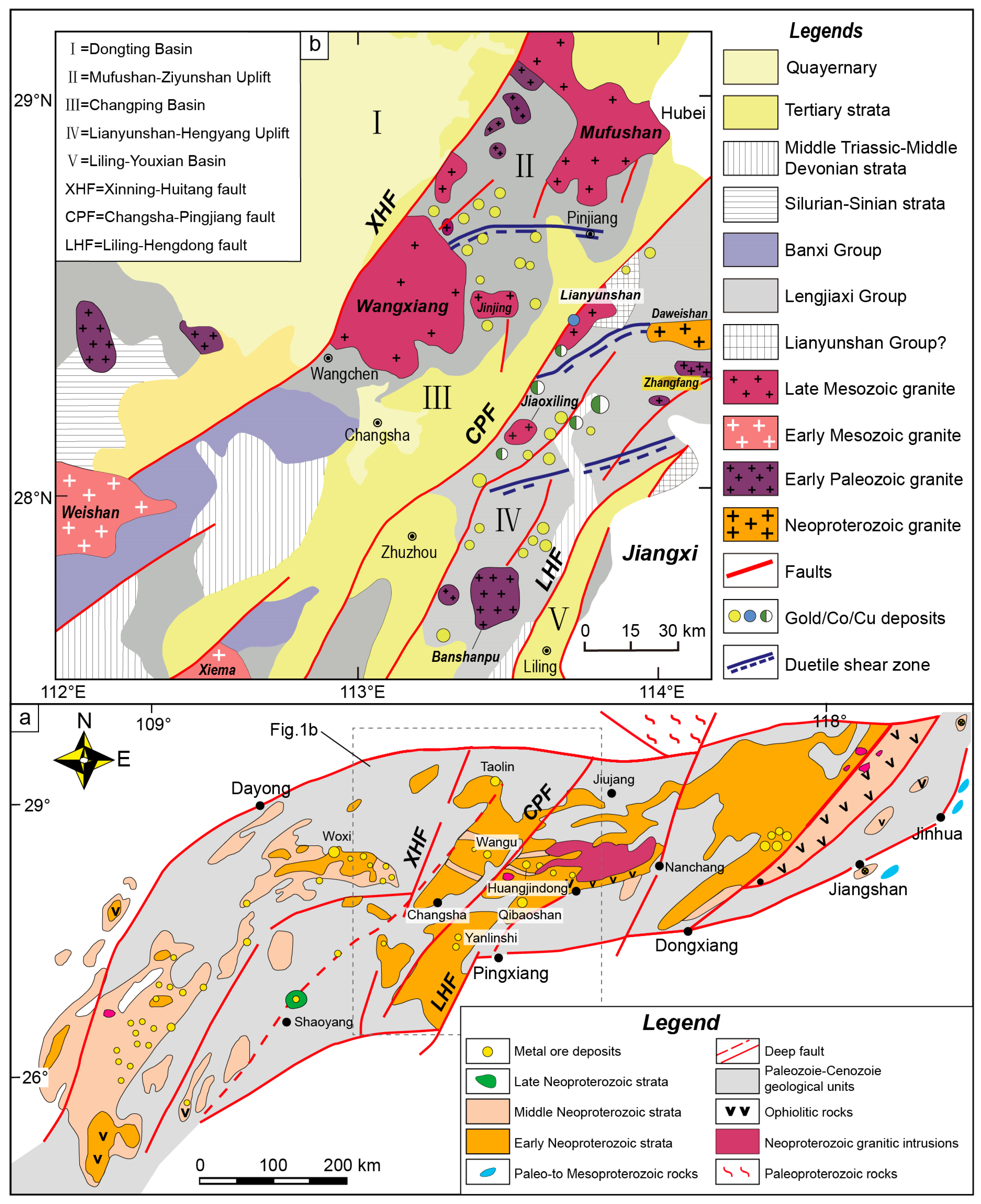
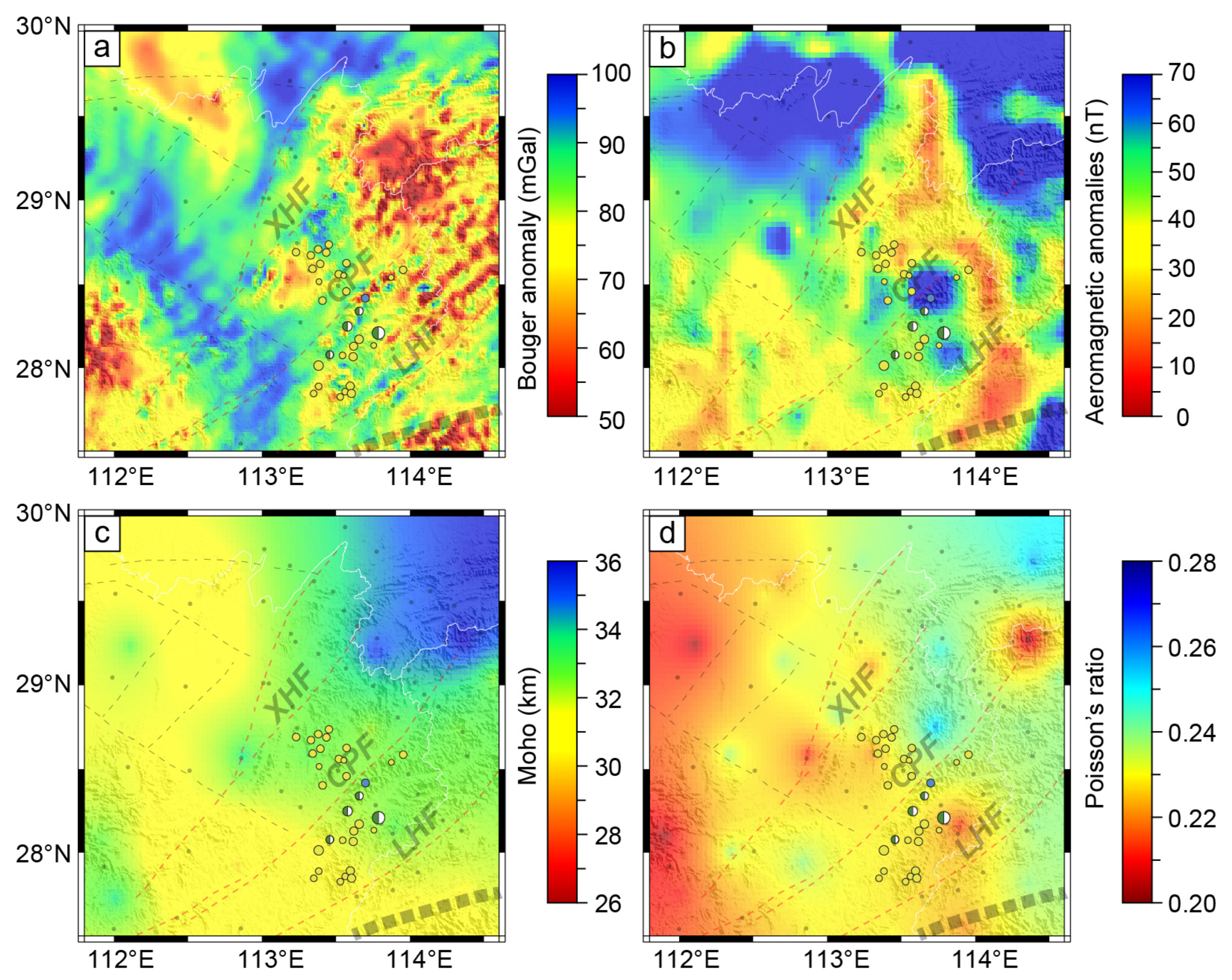
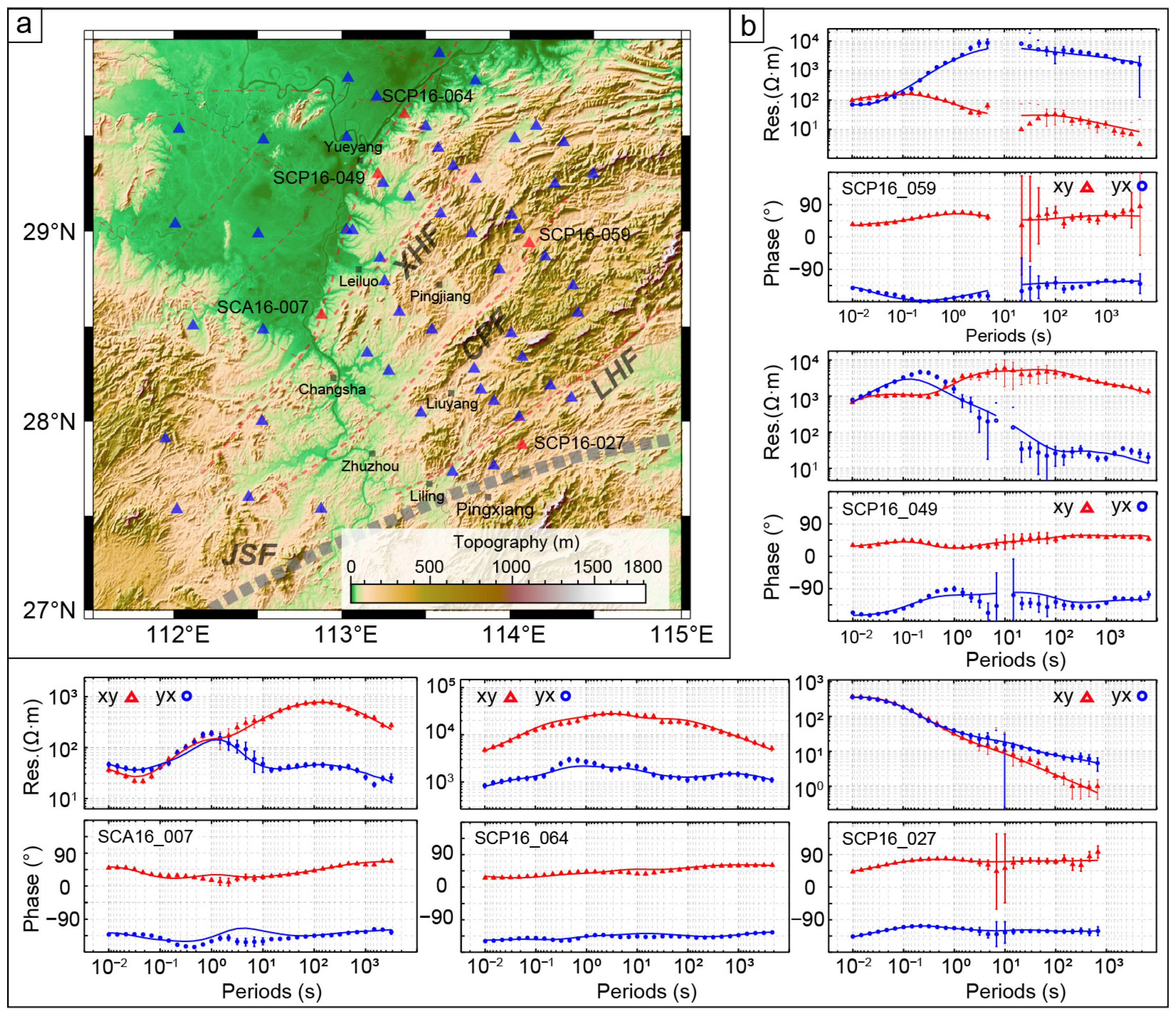
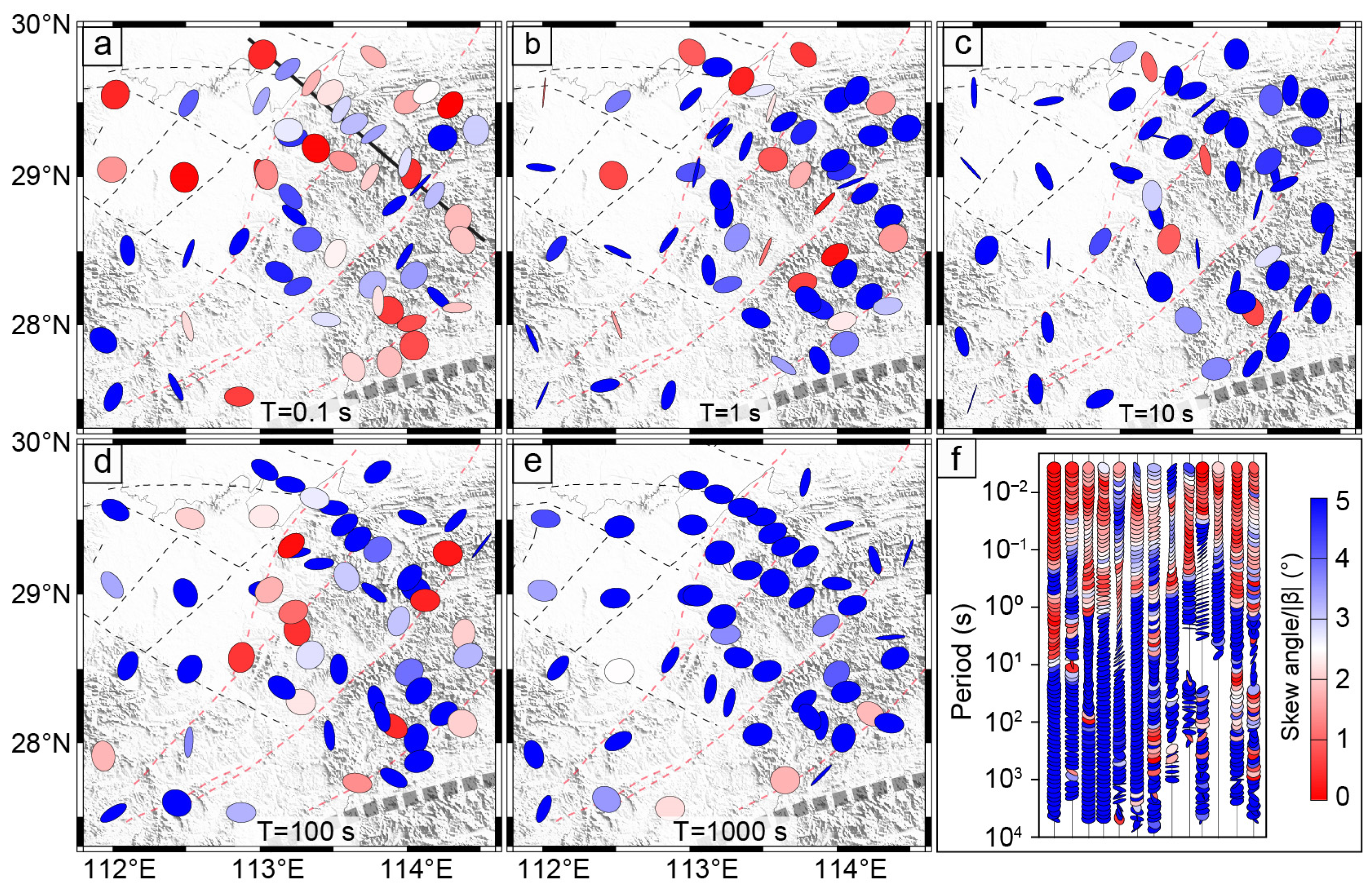





Disclaimer/Publisher’s Note: The statements, opinions and data contained in all publications are solely those of the individual author(s) and contributor(s) and not of MDPI and/or the editor(s). MDPI and/or the editor(s) disclaim responsibility for any injury to people or property resulting from any ideas, methods, instructions or products referred to in the content. |
© 2025 by the authors. Licensee MDPI, Basel, Switzerland. This article is an open access article distributed under the terms and conditions of the Creative Commons Attribution (CC BY) license (https://creativecommons.org/licenses/by/4.0/).
Share and Cite
Liu, C.; Jin, S.; Zhao, G.; Xie, C.; Jing, J.; Sheng, Y.; Dong, H.; Zhang, L.; Yin, Y.; Wei, W. The Relationship Between Tectono-Magmatism and Gold (Polymetallic) Deposits in the Northeastern Hunan Province, Jiangnan Orogen: Insight from Three-Dimensional Electrical Structures. Minerals 2025, 15, 1244. https://doi.org/10.3390/min15121244
Liu C, Jin S, Zhao G, Xie C, Jing J, Sheng Y, Dong H, Zhang L, Yin Y, Wei W. The Relationship Between Tectono-Magmatism and Gold (Polymetallic) Deposits in the Northeastern Hunan Province, Jiangnan Orogen: Insight from Three-Dimensional Electrical Structures. Minerals. 2025; 15(12):1244. https://doi.org/10.3390/min15121244
Chicago/Turabian StyleLiu, Chenggong, Sheng Jin, Gaoyi Zhao, Chengliang Xie, Jian’en Jing, Yue Sheng, Hao Dong, Letian Zhang, Yaotian Yin, and Wenbo Wei. 2025. "The Relationship Between Tectono-Magmatism and Gold (Polymetallic) Deposits in the Northeastern Hunan Province, Jiangnan Orogen: Insight from Three-Dimensional Electrical Structures" Minerals 15, no. 12: 1244. https://doi.org/10.3390/min15121244
APA StyleLiu, C., Jin, S., Zhao, G., Xie, C., Jing, J., Sheng, Y., Dong, H., Zhang, L., Yin, Y., & Wei, W. (2025). The Relationship Between Tectono-Magmatism and Gold (Polymetallic) Deposits in the Northeastern Hunan Province, Jiangnan Orogen: Insight from Three-Dimensional Electrical Structures. Minerals, 15(12), 1244. https://doi.org/10.3390/min15121244





